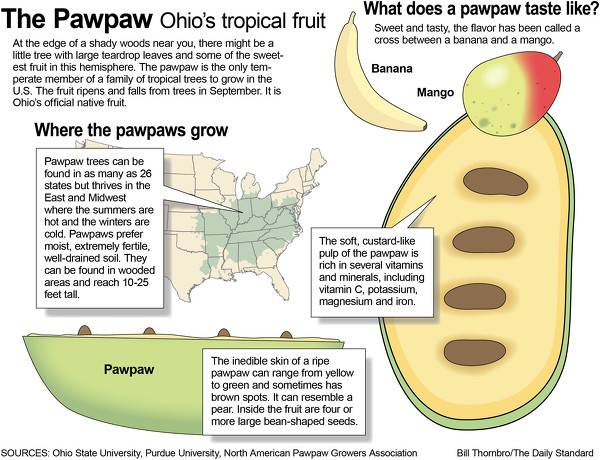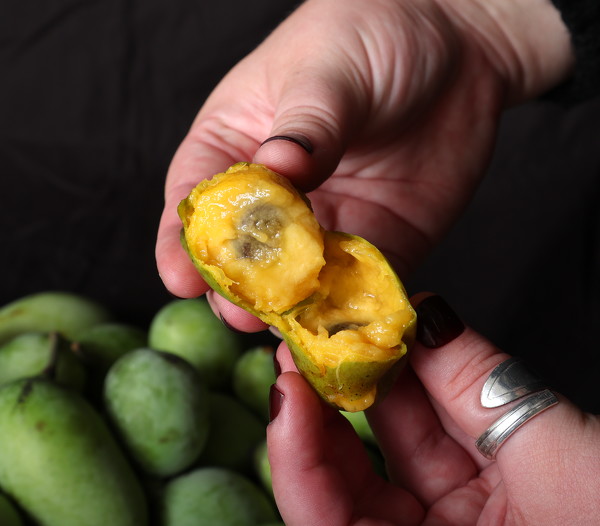
The fruit of the pawpaw is ready to eat right off a tree and tastes like a cross between a banana and mango.
CELINA - A banana and a mango walk into Ohio's woods. A pawpaw comes out.
Nestled in the county's wooded areas are pawpaws, a unique fruit native to Ohio that tastes like a mix between a mango and a banana. The fruit's skin in not unlike a mango, although it is more green or yellow with several sporadic brown spots when on the tree. The meat of the fruit feels tropical with a creamy, almost custard-like consistency. When cut open, the fruit bears several large, black, lima bean-shaped seeds; usually, there are about 12 seeds per fruit. The skin and seeds are inedible.
The pawpaw tree is typically recognized by its large, tropical-looking foliage and prized for its delicious fruits that mature in late summer, according to the Ohio Department of Natural Resources. In the open, a tree can reach 25 feet tall and 15 feet wide. The leaves are large, shiny and often hang down like "dog ears," ODNR states.

Pawpaws grow wild in as many as 26 states.

At the edge of a shady woods near you, there might be a little tree with large teardrop leaves and some of the sweetest fruit in this hemisphere. The pawpaw is the only temperate member of a family of tropical trees to grow in the U.S. The fruit ripens and falls from trees in September. It is Ohio's official native fruit.
Because pawpaws are native to the state, the fruit does exceptionally well in Ohio's climate and is well-suited for Ohio's soil, said Ryan McMichael, Mercer County agriculture and natural resources educator for Ohio State University Extension. The plant is usually free from diseases and pests and can be a host to a couple of different species of butterflies, he said.
As North America's largest native fruit tree, the pawpaw grows wild in 26 eastern states and was discovered by Hernando DeSoto in about 1540. Native Americans routinely enjoyed the sweet treat and even "planted pawpaw trees as they traveled, using the fruit for food along trails and the bark for baskets and making fish nets," according to the North American Pawpaw Growers Association. Pioneers ate pawpaws before apples and other fruits came to America.
Because pawpaws are not well known or readily available, it can be hard to harvest them.
"The issue that we do have with is in terms of marketability is that in order to pick it, you have to allow it to ripen up on a tree to a certain point," McMichael said. "It doesn't have a whole lot of shelf life."

The fruit of the pawpaw is ready to eat right off a tree and tastes like a cross between a banana and mango.

The fruit of the pawpaw is ready to eat right off a tree and tastes like a cross between a banana and mango.
Picking and harvesting pawpaws locally is possible as several area woods are home to the fruit. However, it requires time, energy and knowledge to find and pick the fruit. Often foragers can find the fruit deeper into the woods, but should wear proper footwear and clothing when hiking.
When harvested, the ripe fruit stays good only for a few days at room temperature, but may be kept for a week in the refrigerator, according to the Kentucky State University Cooperative Extension Program.
If the fruit is refrigerated before fully ripening, it can be kept for up to three weeks and can then be allowed to finish ripening at room temperature. Ripe pawpaw flesh, with skin and seeds removed, can be pureed and frozen for later use.
Some people even freeze whole fruits.
McMichael also said that because of its short shelf life, pawpaws aren't typically found in grocery stores and therefore aren't readily available.
However, if and when people do have access to pawpaws, it can be used just like a banana. High in protein, vitamin C, potassium, calcium and other antioxidants, people can eat the fruit raw or use it to make baked goods such as bread, pie and pancakes or other tasty treats such as jam and ice cream. It can also be brewed into beer.

